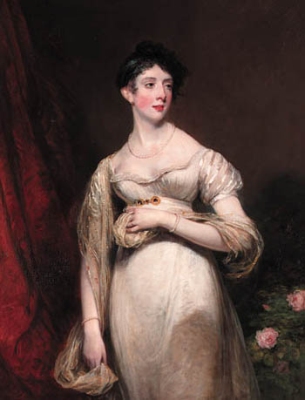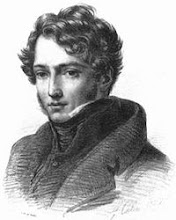Time is Too Slow for those who Wait,Too Swift for those who Fear,Too Long for those who Grieve,Too Short for those who Rejoice;But for those who Love,Time is not.
And now our wishes for you in the New Year...

 Naomi's blog is design at it's best.
Naomi's blog is design at it's best. You will absolutely love Mary's take on Detroit. She has a very good eye.
You will absolutely love Mary's take on Detroit. She has a very good eye. Mimi's blog reads like a chic LifeStyle magazine.
Mimi's blog reads like a chic LifeStyle magazine.Or those slightly defective gentlemen from the regency era.
Lord Castlereagh, Robert Stewart 2nd Marquess of Londonderry if Brougham was my ideal then Castlereagh would have built in me the sort of anxiety that only has precedence in the weary heroines in the earliest gothic romance novels. He was a misguided, narrow-minded, inflexible and hard-working fellow who devoted himself entirely to the wrong side of every major issue in his age. Castlereagh was also Foreign Secretary and Leader of the House. This was written of him by Lord Bryon and accepted by all but his party as truth.
 Robert Banks Jenkinson, 2nd Earl of Liverpool a kindred of sorts to the unfortunate Castlereagh, he was named Prime Minister by the incompetent Prince Regent. Liverpool was a dutiful, pious High Tory and something of a halfwit who at the high of his ineptness in loyalty to the Prinny by then King George IV drew up ‘The Bill of Pains and Penalties,’ against Queen Caroline. The bill was meant to deprive her Majesty of the title, prerogatives, rights, privileges and pretensions of queen consort of the realm and to dissolve the marriage between her and her philandering husband our fat regent-turned-king. The bill failed because Caroline had, as her advocate, my ideal Lord Henry Brougham.
Robert Banks Jenkinson, 2nd Earl of Liverpool a kindred of sorts to the unfortunate Castlereagh, he was named Prime Minister by the incompetent Prince Regent. Liverpool was a dutiful, pious High Tory and something of a halfwit who at the high of his ineptness in loyalty to the Prinny by then King George IV drew up ‘The Bill of Pains and Penalties,’ against Queen Caroline. The bill was meant to deprive her Majesty of the title, prerogatives, rights, privileges and pretensions of queen consort of the realm and to dissolve the marriage between her and her philandering husband our fat regent-turned-king. The bill failed because Caroline had, as her advocate, my ideal Lord Henry Brougham. Dorothea Benckendorff Countess Lieven, a diplomatic woman, and the first foreigner to be honoured as one of the matrons at Almack’s. She is credited with having introduced the German Waltz to Almack’s and was as politically influential as her ambassador husband.
Dorothea Benckendorff Countess Lieven, a diplomatic woman, and the first foreigner to be honoured as one of the matrons at Almack’s. She is credited with having introduced the German Waltz to Almack’s and was as politically influential as her ambassador husband. Sarah Sophia Fane, Sally the Countess Jersey was said to have introduced the first quadrille to Almack’s social club. She was said to be so consumed with not being likened to her husband’s mother (who had an affaire with our fat Prince of Pleasure) that she frequently made an ass of herself trying to sow her good morals.
Sarah Sophia Fane, Sally the Countess Jersey was said to have introduced the first quadrille to Almack’s social club. She was said to be so consumed with not being likened to her husband’s mother (who had an affaire with our fat Prince of Pleasure) that she frequently made an ass of herself trying to sow her good morals. Amelia Anne Stewart Viscountess Castlereagh, later the Marchioness Londonderry, and quite possibly the fussiest of the grand ladies, she is credited with instituting the 'no entrance to Almack’s after eleven o’clock' rule. She is rumoured to have turned away the Duke of Wellington from the doors of Almack's for not wearing proper evening attire.
Amelia Anne Stewart Viscountess Castlereagh, later the Marchioness Londonderry, and quite possibly the fussiest of the grand ladies, she is credited with instituting the 'no entrance to Almack’s after eleven o’clock' rule. She is rumoured to have turned away the Duke of Wellington from the doors of Almack's for not wearing proper evening attire. Emily Mary, Countess Cowper, later Lady Palmerston, was the best of the patronesses and quite possibly the most well-connected. She was mother to a Prime Minister, cousin to Caroline Lamb, the daughter of Lady Melbourne and dear friends with every person of interest.
Emily Mary, Countess Cowper, later Lady Palmerston, was the best of the patronesses and quite possibly the most well-connected. She was mother to a Prime Minister, cousin to Caroline Lamb, the daughter of Lady Melbourne and dear friends with every person of interest. Princess Esterhazy as the youngest of the patronesses, this spiteful child was no different from any attention-starved little sibling.
Princess Esterhazy as the youngest of the patronesses, this spiteful child was no different from any attention-starved little sibling. Maria Margaret Craven, Countess Sefton is the oldest of the patronesses to reign during the Regency. Of brilliant connections and birth, she sponsored the Prince Regent’s mistress Mrs. Fotzherbert’s outing in to London society.
Maria Margaret Craven, Countess Sefton is the oldest of the patronesses to reign during the Regency. Of brilliant connections and birth, she sponsored the Prince Regent’s mistress Mrs. Fotzherbert’s outing in to London society.  William-Adolphe Bouguereau's Dante and Virgil in Hell
William-Adolphe Bouguereau's Dante and Virgil in Hell Portrait of Anne-Marie-Louise by Jacques-Louis David
Portrait of Anne-Marie-Louise by Jacques-Louis David And this is a photo of Thandie Newton, for here she is the very image of my friend ‘B.B’ now happily remarried at forty. She still worries she did not do what was best for her boys. I’m certain she did for this is as far as I concern the only alternative if she had stayed.
And this is a photo of Thandie Newton, for here she is the very image of my friend ‘B.B’ now happily remarried at forty. She still worries she did not do what was best for her boys. I’m certain she did for this is as far as I concern the only alternative if she had stayed.Augustus Frederick, Duke of Sussex was the sixth son of George III. He was mild man who suffered from asthma. He met Lady Augusta Murray while travelling in Italy and the two marry without consent from the king. A year later, the marriage was deemed illegal under the Royal Marriages Act 1772 and annulled in the Prerogative Court but the two continued living together for nearly decade despite it. They had two children whom she retained custody of when they seperated. A year after Augusta's death he married in accordance to Royal Marriages Act, to Lady Cecilia Letitia Buggin. They had no children and he died without a legitimate heir.
Sussex was firm in his liberal opinions, he was a scientist, patron of the arts and collector of books. He was also Queen Victoria's favourite uncle and the one who gave her away at her wedding to Prince Albert.


You need only follow the link directly below and voilà.
 There is no need to be shy. I'm new too so we'll keep each other's company.
There is no need to be shy. I'm new too so we'll keep each other's company. I'm taking my tea on holiday. In some exotic land but with all the usual fare so come alone for I've poured you a cup.
I'm taking my tea on holiday. In some exotic land but with all the usual fare so come alone for I've poured you a cup. Isn't the table charming? I've settled on a restrained androgynie in order not to alienate those unaccustomed to the pomp and circumstance of high tea.
Isn't the table charming? I've settled on a restrained androgynie in order not to alienate those unaccustomed to the pomp and circumstance of high tea. Now, if your mother is anything like my crazy Jamaican mother, you are by now well convinced that a cup of tea is the 'cure-all' for whatever ails you from complex heartache to simple upset stomach. I swear no matter what my complaint she would have a tea to suggest.
Now, if your mother is anything like my crazy Jamaican mother, you are by now well convinced that a cup of tea is the 'cure-all' for whatever ails you from complex heartache to simple upset stomach. I swear no matter what my complaint she would have a tea to suggest. Rooibos/red tea to cure insomnia. Camomile as a muscle relaxant. Green tea to say young. White tea for healthy skin, Ginger and peppermint tea aids in digestion, Jasmine tea for aroma therapy and on and on. I'm telling you the woman is relentless but I digress, we are for tea you and I.
Rooibos/red tea to cure insomnia. Camomile as a muscle relaxant. Green tea to say young. White tea for healthy skin, Ginger and peppermint tea aids in digestion, Jasmine tea for aroma therapy and on and on. I'm telling you the woman is relentless but I digress, we are for tea you and I. Mrs Dorothea Jordan she gave the Duke of Clarence ten illegitimate children and though she was a scandalous creature, she was praised enthusiastically by all the great romantic writers of her time from Byron to Lamb. She was a mistress generous to fault, returning to the stage between pregnancies in order to support herself, the children and her royal duke. The poor dear died a pauper in France while her duke went on to marry then later he became King William IV.
Mrs Dorothea Jordan she gave the Duke of Clarence ten illegitimate children and though she was a scandalous creature, she was praised enthusiastically by all the great romantic writers of her time from Byron to Lamb. She was a mistress generous to fault, returning to the stage between pregnancies in order to support herself, the children and her royal duke. The poor dear died a pauper in France while her duke went on to marry then later he became King William IV. Harriette Wilson was a brilliant courtesan who, according to Sir Walter Scott, was ‘far from beautiful …but a smart, saucy girl with good eyes and dark hair and the manners of a wild schoolboy.’ Harriette was popular until she wrote her memoirs, but to be fair she did, ahead of the publication date of the scandalous manuscript, write everyone who could be incriminated making it clear that they would still save face for a mere £200. The Duke of Wellington, stupidly refused and she in turn wrote this by his name in the published text, “sighed over me and groaned over me by the hour,” but then she never thought much of Wellington who, she was quoted as saying, looked like a ‘Rat-catcher.’
Harriette Wilson was a brilliant courtesan who, according to Sir Walter Scott, was ‘far from beautiful …but a smart, saucy girl with good eyes and dark hair and the manners of a wild schoolboy.’ Harriette was popular until she wrote her memoirs, but to be fair she did, ahead of the publication date of the scandalous manuscript, write everyone who could be incriminated making it clear that they would still save face for a mere £200. The Duke of Wellington, stupidly refused and she in turn wrote this by his name in the published text, “sighed over me and groaned over me by the hour,” but then she never thought much of Wellington who, she was quoted as saying, looked like a ‘Rat-catcher.’






